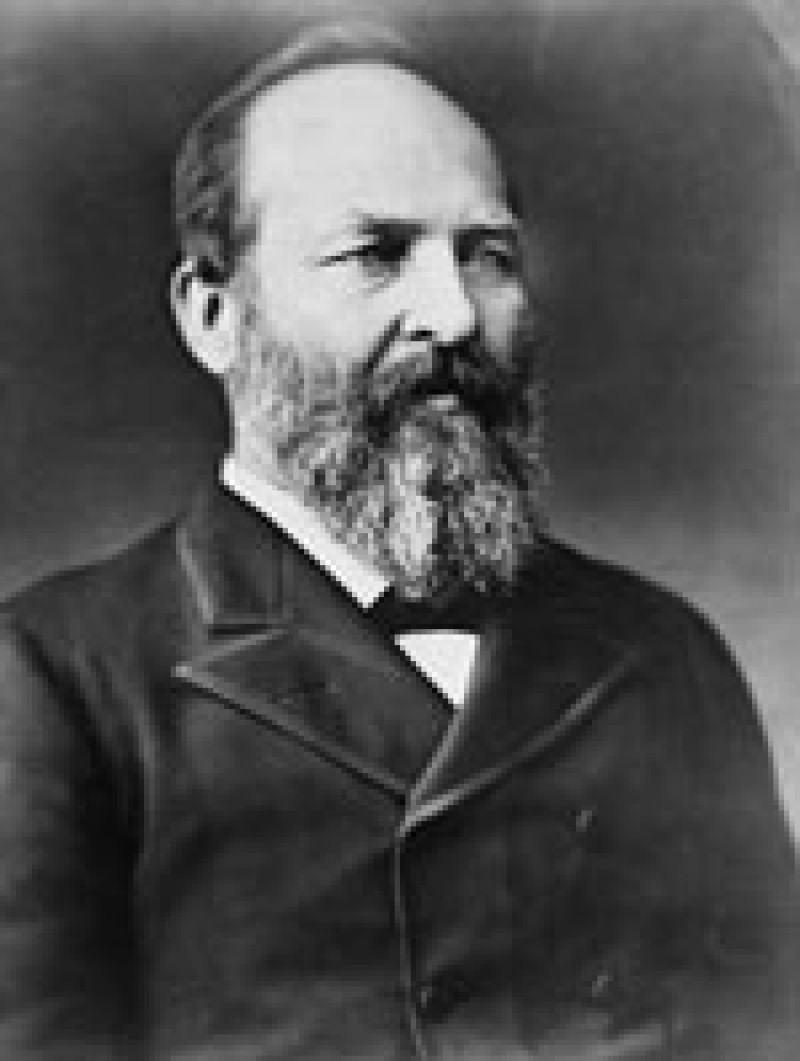James Abram Garfield (Nov. 19, 1831 - Sept. 19, 1881)
James Abram Garfield, 20th president of the United States, was born in Orange township (now Moreland Hills) in the Western Reserve region of northern Ohio. After his father's death in 1833, James was brought up amid rural poverty by his strong-willed mother.
Conversion, at age 18, to the Disciples of Christ gave young Garfield a sense of self-worth; education, especially in classical languages, gave him his first vocation. In 1851 he entered the Western Reserve Eclectic Institute (now Hiram College), and three years later he enrolled at Williams College in Massachusetts, receiving his A.B. in 1856.
After graduation, Garfield returned to Hiram as professor of ancient languages, and in 1857 he was named president of the tiny school. Elected as a Republican to the Ohio legislature in 1859, he expressed antislavery views in the heated debates during the secession crisis. When that crisis exploded into the Civil War, he helped recruit the 42nd Ohio Volunteer Infantry and was commissioned colonel of the regiment and was eventually promoted to brigadier general.
In September 1862 they engineered his nomination for Congress from Ohio's 19th District. In such a solidly Republican district, nomination was tantamount to election, and Garfield won a lopsided triumph, the first of nine consecutive victories.
While waiting for the 38th Congress to assemble, Garfield served in the Army of the Cumberland as chief of staff to Major General William S. Rosecrans.
In December 1863 Garfield resigned his commission to take his seat in Congress. He initially joined the ranks of Republicans who were impatient with President Abraham Lincoln's seemingly cautious moves toward full emancipation, but after the war Garfield 's radicalism moderated. Although in 1868 he supported the impeachment of President Andrew Johnson, he felt increasingly uncomfortable in the role of firebrand. His interests shifted to matters of financial policy. He worked tenaciously for these policies on the House Ways and Means Committee and as chairman of the Appropriations Committee during the 42nd and 43rd Congresses.
In 1873 Garfield's political career was threatened by a series of scandals. The most damaging was the accusation that he had once accepted stock in the notorious Credit Mobilier corporation. After a hard-fought reelection battle in 1874, Garfield was returned to his congressional seat.
In January 1880, the Ohio legislature elected Garfield to the U.S. Senate. To smooth his path to the Senate, Garfield had to agree to support Treasury Secretary John Sherman's presidential bid and put aside, for the time being, his own presidential ambitions. At the 1880 Republican National Convention Garfield served as floor manager for Sherman's campaign and even placed his name in nomination.
Between his election and his inauguration on March 4, 1881, Garfield was occupied with constructing a cabinet that would balance all Republican factions.
This unedifying squabble would consume the energies of the brief Garfield presidency. It overshadowed promising activities such as Blaine's efforts to build closer ties with Latin America, Postmaster General James's investigation of the star route postal frauds and Secretary of the Treasury William Windom's successful refinancing of the federal debt.
He had little time to savor his triumph. On July 2, 1881, as Garfield was waiting at the Baltimore and Potomac station for a train to carry him to his summer vacation, a shabby, unhinged religious fanatic named Charles J. Guiteau pumped two .44-caliber bullets into his back. Mortally wounded, the president was carried back to the White House where he slowly wasted away, as an anxious nation hung on the daily medical bulletins from his sick room. In September he was transferred to Elberon, New Jersey, to escape the Washington heat, and there he died.
Some content and graphic elements featured on webpages related to the Thomas J. Moyer Ohio Judicial Center were used with the permission of the Ohio Historical Society; the Prints and Photographs Division of the Library of Congress; the Office of the Curator of the Supreme Court of the United States and American National Biography Online.
Biography of James A. Garfield (Nov. 19, 1831 - Sept. 19, 1881)
Citation: Allan Peskin. "Garfield, James Abram"; http://www.anb.org/articles/05/05-00264.html; American National Biography Online Feb. 2000. Access Date: Fri Oct 3 09:48:38 2003. Copyright © 2000 American Council of Learned Societies. Published by Oxford University Press. All Rights Reserved.
Portrait of James A. Garfield - Library of Congress, Prints & Photographs Division.

